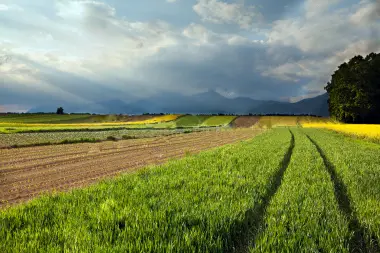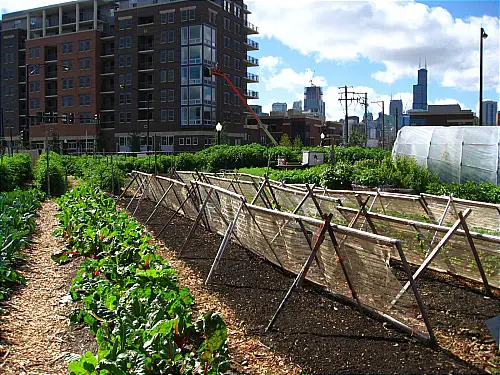The challenge of growing enough food to feed the planet is not a problem that belongs to just one country. Food comes from all around the world to sit on our tables and we in return ship our food products to far-off countries.
Take a look at some of the things scientists are doing to make sure that we’ll all have enough to eat in the upcoming decades and some of the newest and innovative technology:

1. Turn Deserts to Farmland
As Charlie Paton was flying to Morocco, he couldn’t help but notice the contrast between the desert and ocean. Nearly 70% of the world’s fresh water is used for agricultural purposes. Meanwhile, here was this vast dry land sitting next to water too salty to use.
So Paton designed the Seawater Greenhouse, which uses simple evaporation to turn salt water to fresh while at the same time providing a place for growing just about any crop. It’s an ingenious solution to two problems – finding enough fresh water and creating growth in the desert.
2. Precision Agriculture
American farmers use anywhere from 300 to 500 pounds of fertilizer per acre. But new “soil sensors” that continuously monitor soil conditions like water and temperature allow farmers to make huge cuts in the number of resources used by letting them know exactly when and how much fertilizer is needed.
Similar systems have been used in the past, but they required antennas that often got knocked over. The new sensors are buried 12 inches underground and transmit data via radio waves. By using the sensors, farmers can expect to save around $120 per acre each growing season.
3. Build a Better Rice
Rice is a staple crop that feeds nearly half the world’s population. One of the problems, though, is getting the rice to the people who need it. John Sheehy from the Rice Research Institute in the Philippines is working to make rice grow faster by altering its photosynthesis – the way it grows using the energy from the sun.
The goal is to increase rice production by as much as 50% annually. And once they crack the code with rice, they can use the same process to increase yields from other plants.
4. Find a Better Fertilizer
It’s suggested that 1.2% of all greenhouse gasses come from chemical fertilizer production. The last 30 years have seen tremendous growth in the number of fertilizer farmers use, and that growth is expected to continue unless scientists at Michigan State University get their way.
They are developing a mix of microbes that actually provide the nutrients plants need and provide protection against pathogens. As an added benefit, the microbes only need to be applied once, unlike fertilizers that you must apply each year.
5. Update The Maps
The last 40 years have seen relatively little improvement in crop yields throughout sub-Saharan Africa. To help increase food yields to a point where farmers can provide sustenance for the local population, companies like HarvestChoice are gathering massive amounts of data on land use so that you can develop better farming techniques.
By understanding all the variables that affect farming, better decisions can be made for land use.
6. Hire a Robot
Many types of produce depend on having people in the field for harvest. However, tougher immigration laws have helped to shrink the labor pool. Farmers are having a hard time finding workers that millions of dollars of labor-intensive fruit like apples and grapes have rotted in the fields.
Researchers worldwide are working to develop mechanized workers – robots – that can do everything from monitoring crops to pruning to actual harvest.
While there are already used for monitoring and applying fertilizer or water, robots that do the delicate work of harvest are still cost-prohibitive and slow. In the meantime, machines allow smaller numbers of workers to accomplish great amounts of work.
7. Bring the Soil
Back to Life Across the globe, man has been killing the soil. It’s estimated that as much as 25% of arable lands have been degraded by over-farming or deforestation. But by adding biochar – a type of charcoal – the lands can be made available for farming again.
Not only does it make farming more sustainable, but it also locks carbon into the soil rather than letting it escape into the air.
8. Create a Super Food
One-third of the people in Africa suffer from malnutrition. Cassava root is easy to grow and inexpensive. Unfortunately, it’s low in iron and other important vitamins. So, scientists are working to develop cassava that is more nutritious and slower to rot in hopes of providing cheap nutrition across the continent.
Read also: How to Make and Maintain a Worm Farm
5 Significant Facts About Farm Water Conservation
The U.S. agricultural industry, particularly farming, consumes a vast amount of the nation’s available freshwater and demands strict attention to this use.

The most recent U.S. Geological Survey (USGS) survey on water use estimates that withdrawals for irrigation accounted for 37% of all water use in the country; 67%, if used for thermoelectric cooling, is excluded from the average. This comes to 128 billion gallons of water per day for farming.
Recent droughts across the U.S. and growing legal concerns over water rights accentuate the growing issue of water scarcity and the need for better resource management. Examining these significant facts about water consumption and farming can help draw more attention to the importance of responsible water use and encourage better understanding.
1. Drip Irrigation Most Resource-Friendly
Most farmers no doubt know which type of irrigation best suits their crops, but for the uninitiated, it’s important to note that there are different types of irrigation and that the right choice can make a huge difference in how much water is utilized or wasted.
Among the various types of irrigation, including surface and sub-irrigation, drip irrigation is arguably the most effective method for how much water is saved by avoiding evaporation and runoff. Drip irrigation works by distributing drops of water near the roots of plants on a schedule that maximizes absorption and minimizes waste.
2. Runoff A Runaway Problem
Agricultural runoff has long been known to be one of the largest drains on the nation’s water resources, pun intended. Runoff occurs when crops are overwatered and/or poorly irrigated and can result in massive water loss.
It can also cause severe pollution problems when runoff laced with pesticides and other chemicals leaches into aquifers or is introduced to water sources. This problem is most effectively combated by choosing irrigation methods that are well-suited to the crop and soil type and properly monitored.
3. Water Laws Favor Farmers
Many people who advocate for more responsible water use think legislative enforcement may be the answer to encouraging stewardship of natural resources in the agricultural community. Still, the fact is that farmers typically enjoy the power to negotiate water use when the resource is available.
Regardless of whether farmers’ rights fall under riparian or prior appropriation legal theories, farmers are known to engage in water-rights transfers and obtain support from the state in times of need. While more restrictive legislation is not necessarily the answer, it is important to note that there are few avenues of recourse for one who suffers from water management abuses.
4. Easy Irrigation Efficiency
Some things farmers could change about their irrigation plan may be very difficult and/or expensive, but some simple choices can save water and money.
For one, farmers should always keep in mind that being allowed to irrigate doesn’t mean it is necessary. Some water districts set specific times and amounts for irrigation, and it may occur to a farmer to use what is allocated regardless of need. This is wasteful. Other tips include irrigating in the mornings when temperatures and winds are lower, evaporation is less, and not irrigating when rain is predicted.
5. Current Use Levels Unsustainable
Perhaps most important among these facts is that areas in the U.S. cannot sustain the current level of water used by their farmers.
The World Business Council for Sustainable Development has estimated that 15% to 35% of the world’s current water use for irrigation is unsustainable. The western U.S. is a particular area of concern. This means that farmers in California, Arizona, and a few others will be forced to consider allocating water more efficiently, and the sooner the issue is addressed, the better.
Remember …
Agriculture is an extremely important part of America’s economy and society, but nothing trumps the value of water. More efficient and responsible water use is a goal shared by all and not solely shouldered by farmers.

